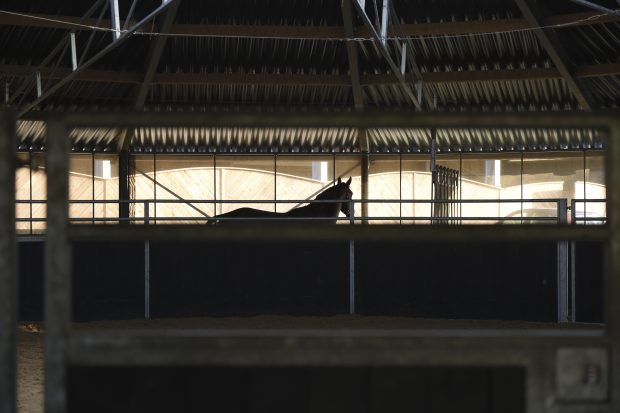Used correctly, a horse walker offers many advantages — it is a great time-saver while also benefiting the horse.
A walker may seem monotonous and impersonal, but most horses seem to adapt quickly and appear happy. In the winter months, when time is short, many yards find their walker extremely useful.
“They are not a replacement for riding,” says Sally Anne Johnson, from Gloucestershire, who has three horses. “But I am on my own and I live on a main road. When the weather’s bad it’s not always possible to ride — I find it invaluable. I don’t know how I survived without one.”
“They need to march”
“Assuming they are well designed, of an adequate diameter, with an appropriate surface and the speed is set correctly, they are a good [thing],” says Dr Sue Dyson, head of clinical orthopaedics at the Animal Health Trust.
“The horses shouldn’t just be ambling along though, they need to march, using their bodies constructively — and then it’s really [beneficial] for their core. They’re good for warming up, cooling down or extra exercise.”
“The main thing is to make sure the circle is big enough for your horses,” adds equine anatomist Gillian Higgins. “If the circle diameter is too small you are constantly twisting the joints — and you need a good, giving surface. But they do keep the horses moving and it’s much better than standing in the stable all day.”
Horses can be put on the walker while mucking out is being done — if it’s in sight — so when you have finished the yard, your horse is already warmed up. In addition, they can be put on them after being ridden to cool down, which can cut riding time down if needs be.
People have also found walkers invaluable for rehabilitation. However they’re not suitable for all injuries, warns Sue. “It depends on the injury — some injuries are exacerbated by walking in a circle,” she explains. Gillian also cautions: “You have to be careful. With some injuries it’s best to walk in straight lines.”
The safety question
Leaving horses on the walker for too long, or getting them on and off while it is still moving, is not advisable.
“Most problems come as a result of human error,” explains Ashley Morsely from Molenkoning. “People get complacent. The walker should always be supervised — you need to be able to glance at it, not tuck it away behind the barn.”
Most walkers have safety features — the dividers are made of mesh and rubber, and some have emergency stop buttons.
Don’t forget to alternate the direction of the walker— some yards change the direction on alternate days. Just as in the school, this ensures that horses work both sides of their bodies, avoiding unequal stress on joints, for example.
It is best to pick the biggest walker you can afford, so the horses turn in a large circle. There are also oval walkers so that the horses work in straight lines as well as on a turn.
The cost varies depending whether you provide your own exterior fencing and base , or whether the company making the mechanisn, also provides these and other features, such as a roof.
Ref: Horse & Hound; 4 December 2014.



